Cats in Hats
By The Hatching CatOld-Time Cats on the Clock
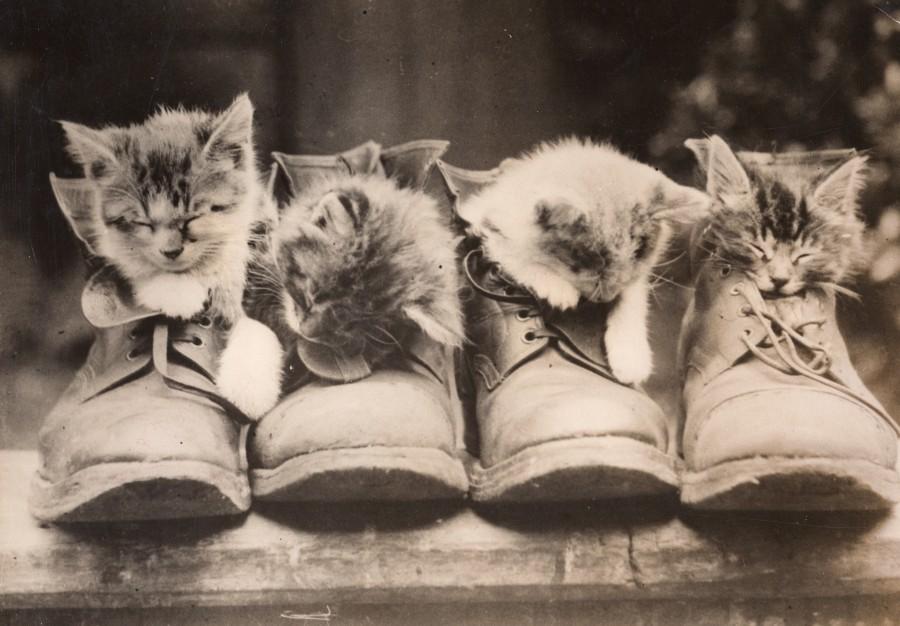
1943: Pooli, the Coast Guard Cat Who Rated 3 Service Ribbons and 4 Battle Stars
This Cats in Hats tale comes from Hawaii, the home of Pooli, short for Princess Papule. Pooli was a World War II veteran cat of the Coast Guard when she turned 15 in 1959. She was born at the Unites States Naval Base at Pearl Harbor on July 4, 1944.
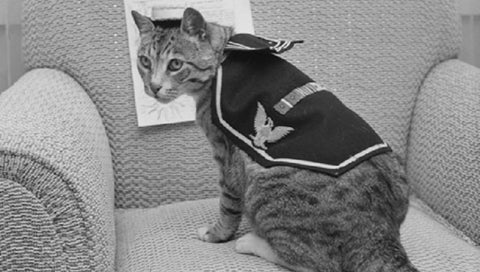
According to her owner, Benjamin H. Kirk, Pooli was taken aboard the attack transport USS Fremont by his nephew, James L. Lynch. Pooli served as the ship’s mascot, and saw action at the Marianas, the Palau group, and Iwo Jima. She even crossed the equator during her time of service.
Pooli was not much of a wartime sailor, in that she avoided human battles at all costs. Whenever the battle stations rang, she’d head for the mail room and curl up in a mail sack. Faced with a neighborhood cat or dog though, she was not afraid to fight for her territory, and she never lost any of those battles.
The only time Pooli came close to being a wartime casualty was when some of the sailors talked of throwing her overboard because they feared they would have to go to quarantine in San Francisco because of that cat. A round-the-clock guard came to her rescue, allowing her to stay with him on the ship while it remained docked for a few days.
By the time Pooli turned 15 in 1959, she was deaf and had only her front teeth left. However, as the photo above shows, she was still able to fit into her old uniform and show off her ribbons and stars to the press.
1871: Tabitha, the Post Office Cat Who Survived the Great Chicago Fire
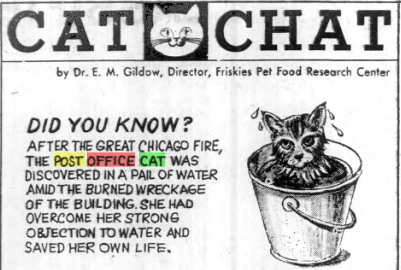
My first Cats in Hats story is about a cat named Tabitha who wore the hat of a post office mouser.
If you are of a certain generation, you have no doubt heard the story of Mrs. O’Leary’s cow and how she knocked over a kerosene lamp, starting the Chicago Fire of 1871. But have you heard the one about the Chicago Post Office cat that survived the flames?
The Chicago Post Office and Custom House was built in 1855 on land the U.S. Government had acquired at the corner of Dearborn and Monroe Streets. The fireproof building was one of many destroyed in the great conflagration that started in the barn of Patrick and Catherine O’Leary on October 8, 1871.
One newspaper said this about the destruction of the post office building during the fire:
The roof collapsed; the floors gave way one after another; the desks and other furniture perished in a whirl of flame; greenbacks burned and gold melted in the safes; solid granite beams fell to pieces, and iron beams were twisted till they looked like a gigantic dish of baked vermicelli.” But the cat survived in a bucket of water in the basement.

But Tabitha the post office cat somehow survived. According to The New York Times:
The office cat had once before been burnt out, and was, therefore, in a measure prepared for this calamity. On the night of the fire the cat was present, but did not go. When the work of removing the safes was in progress, the tearing away of a portion of the ruin revealed the faithful public servant in a pail partially filled with water, apparently enjoying the shelter it afforded.
From her position it appeared impossible that she could have gone away and returned after the fire, and so she may be set down as the only living being who passed the time in the burnt district.”

Like all female post office cats of her time, Tabitha gave birth to many kittens, all of whom found good homes in Chicago and other cities. Some of the kittens became domesticated, but many others were given to post offices in Washington, New York, Boston, St. Louis, and San Francisco.
Following Tabitha’s death on July 20, 1872, her son Master Thomas Cat took over her job at the Chicago Post Office as “a faithful sentinel on the watch-tower to defend it against the depredations of its destructive enemies, the rats and mice.”
If you enjoyed this Cats in Hats tale, you may like to read about Kaiser, the office cat or Miss Bacillus the guinea pig, both of whom survived the great Equitable Life fire in New York City in 1912.
1923: Mister Meyer, the Milk Steward of the S.S. President Harding
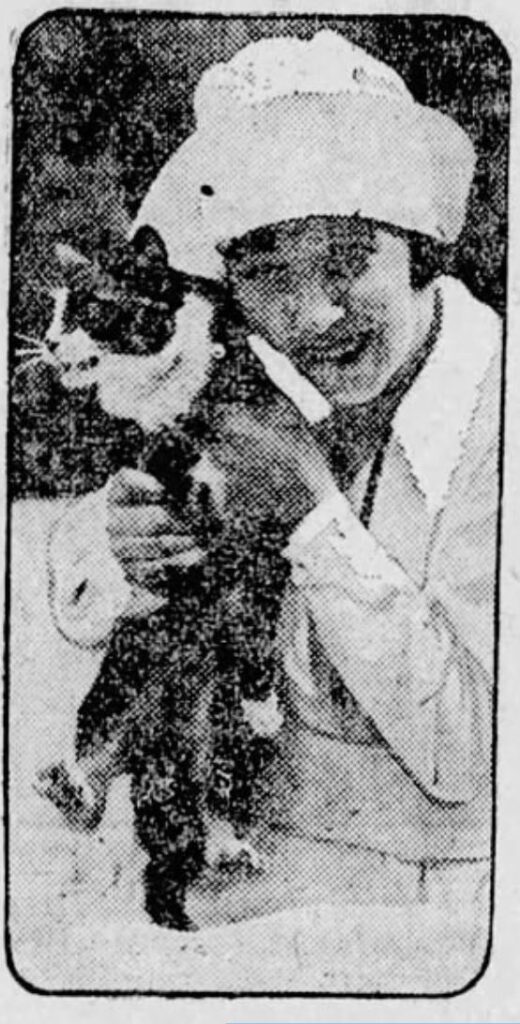
The following Cats in Hats tale is about a cat who served on the passenger ship S.S. President Harding, which sailed from New York to Bremerhaven, Germany, during the 1920s. His title was “Milk Steward,” and along with the Chief Steward Billie Lynn, he reigned over the galley and dining room during meal hours.
Mr. Meyer was discovered on the ship in 1923, when he was just a tiny Tuxedo kitten. The Master-at-Arms found him on the promenade deck while the ship was in Breman (Bremerhaven). His tiny meows sounded so much like “Meyer” that the dining room stewards christened him by that name. (The cat, though, refused to respond to anyone unless they called him Mr. Meyer.)
Right from the start, the cat decided that the galley and dining room would be his headquarters. He attached himself to the pantryman, whose job it was to bring milk from the large refrigerators to the galley. Mr. Meyer would meow nonstop until someone opened a can and poured some milk in his bowl.
Once Mr. Meyer got his sea legs, he began exploring the ship, making his way from the bridge to the engine room. After a complete inspection of the ship, he decided that the galley and dining room were still the best place to work.
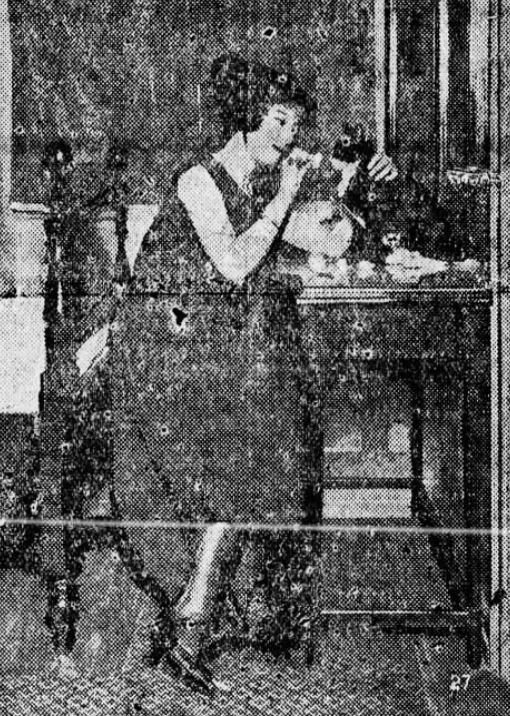
It was here he would nap during his off hours and sit “dignifiedly erect” during mealtime. Mr. Meyer was well aware that Captain Paul C. Grening was in charge of the ship, so he always made sure to sit by the skipper’s chair at the captain’s table.
According to news reports, Mr. Meyer was always well behaved; he never got under anyone’s feet, begged for food, or attempted to jump on a guest’s lap. He also refused to be petted whenever he was on duty. My own cats could have used some lessons from this cat.
He did enjoy being petting when he was off duty, especially by young women. He seemed to love perfume, and would always accept a sniff of a perfumed scarf or handkerchief. He also enjoyed having his fluffy white chest dabbed with a powder puff–he would often visit the rooms of young ladies, who would dab him with scented powder.
One day about a year after Mr. Meyer joined the crew, he made a mistake while taking leave in New York. Instead of returning to the S.S. President Harding, he boarded the S.S. President Polk. When the President Polk docked in Breman, Mr. Meyer disembarked and boarded the President Harding, which had arrived around the same time.
This concludes this Cats in Hats story. Wouldn’t it be wonderful if passenger ships could have cats again?!




